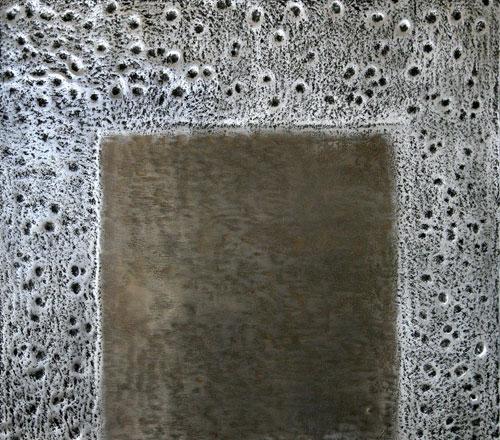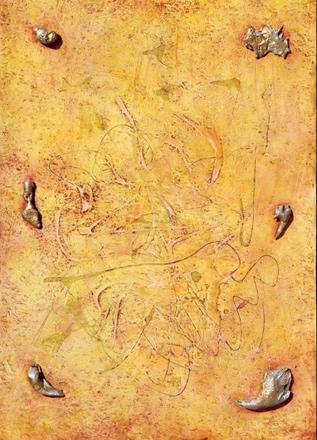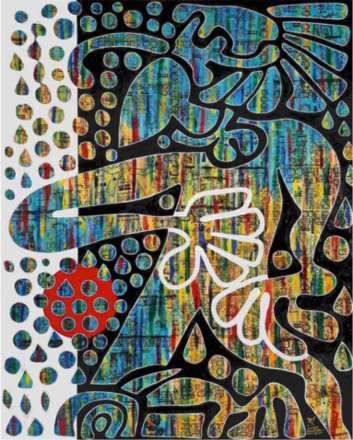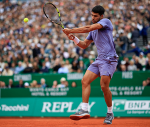You are here
Mysteries to decipher
By Ica Wahbeh - Feb 15,2015 - Last updated at Feb 15,2015

AMMAN — “It makes no sense to reproduce reality as we see it,” says artist Fausto Borge, “that is why I became an abstract painter.”
His abstracts on display at Nabad Art Gallery, an attempt to follow the “dynamics” and “evolution” of objects, are inspired by “what we do not see”.
“This reality is a fiction; we only comprehend 1 per cent of what it is,” says Borge, which must be why he seems compelled to “erase what is explicit”, the “sharp edges and contrasts” of an “opaque” reality, leaving the viewer with mysteries to decipher in a world of his own creation.
Avowedly influenced by sciences — “I love physics, chemistry; I worked as a mason and as a car mechanic when I was a student” — Borge then has to reconcile order and minuteness with his rejection of reality as a comprehensible concept.
The result: a collection aptly titled “Order and Chaos”, a stunning set of abstracts that may get a perfunctory look from a casual viewer but that require long scrutiny from a more inquisitive soul seeking to “read” his message.
The envoy of the Bolivarian Republic of Venezuela to Jordan, the artist is an ambassador in more than one way: representing his country as a diplomat, but also presenting art to the world at large.
“The recumbent”, the work that meets the viewer at the entry to the gallery, and one of few titled, may suggest, as its title implies, a body lying in a wooden receptacle, but it could also be cooling magma in some primordial earth crust formation, a window to a fiery horizon or a prehistoric monolith, man’s first attempt at leaving something to his likeness to the future.
This almost monumental work is offset by five small ones on the adjoining wall. It is as if the artist decided to deconstruct the “whole” into several components, recognisable yet different, and leave it for the viewer to choose which he can relate to better.
The smaller abstracts are created by geometrical patterns — order — or images reminiscent of cave paintings, a few “chaotic” outlines hinting at some form of life.
And then, like a conductor changing tenor, the artist presents a different kind of work. Small paper paintings are replaced by bigger sculptural metal representations, solid yet soft, permanent yet fragile.
The “Homage to Rothko” — who, incidentally, like Pollock, was a student at the Arts Students League of New York, where Borge also studied from 1980 to 1983 — is a sober silver aluminium square on which, playing with texture, the artist creates another square almost three dimensional, bringing to mind cubism.
But if this image is rather trompe l’oeil, “An ancient bread recipe” is truly in relief.
A blue wooden background supports aluminium squiggles, little shiny, playful blobs that create an imaginary text of a bread recipe, known to the artist but a total mystery for the viewer.
Then it is paper, again, dainty abstracts in colours that defy description and challenge imagination, juxtaposed to big wood works in such seamless fashion that one has difficulty distinguishing one medium from another.
The temptation to touch the works is irresistible. Their surface is smooth, despite appearing rugged and ridged, almost sensual, in warm, earthly colours. Their enigmatic imagery lends itself to interpretation.
Aluminium in Borge’s hands is pliant. But then, he confesses using the torch as his brush. It moulds and smelts to become a starry night, the lights of a city seen from high above, a bubbly magic potion or gold nuggets buried in dark basalt.
It becomes, in other instances, flattened ore placed by the artist haphazardly on wood in apparent chaos to create, depending on one’s imagination, arcane heraldry or some exotic plant.
Borge plays with texture skilfully to create depth and movement.
Whether paper, canvas, wood or aluminium, his works, in subdued, soothing, almost monochromatic colours, are rich and intriguing. They reflect the artist’s distinct aesthetic and a wealth of artistic experience.
Each painting, the artist says, is a project; each object has its own dynamism whose evolution and effect he follows to create his reality, one only he can see and we only can hope to understand.
In Jordan for five years now, Borge, who was “always able to draw” is content to have been able to create a workshop in the basement of his residence, where he can put to good work this natural skill, finely honed in schools in the US and France.
“I became a painter when I was 30. I studied painting in New York, engraving under the direction of Krishna Reddy and conventional painting at the Arts Students League of New York.”
Further studies in France yielded a certificate in aesthetics and a master’s degree in sociology from the University of Bordeaux.
Born in Costa Rica, when he was “five or six” his parents emigrated to Venezuela, a country with which he entirely identifies.
“Even though I have French nationality, as I lived for 20 years in France, I consider myself Venezuelan.”
Since 1982, Borge has held solo exhibitions in France, Venezuela and now Amman, and participated in group exhibitions in the US, France and Venezuela.
His “Amman period” is on display until March 11.
Related Articles
AMMAN — Simply called “The Amman Period”, Venezuelan artist Fausto Borge’s exhibition at Jordan National Gallery of Fine Arts is the result
ZURICH — The International Art Fair in Zurich, a significant hub in the contemporary art scene since its inception in 1999, returned in Octo
AMMAN — The Zara Gallery on Wednesday inaugurated a group exhibition by Jordanian female artists, under the title “Delicate Lines of Strengt


















